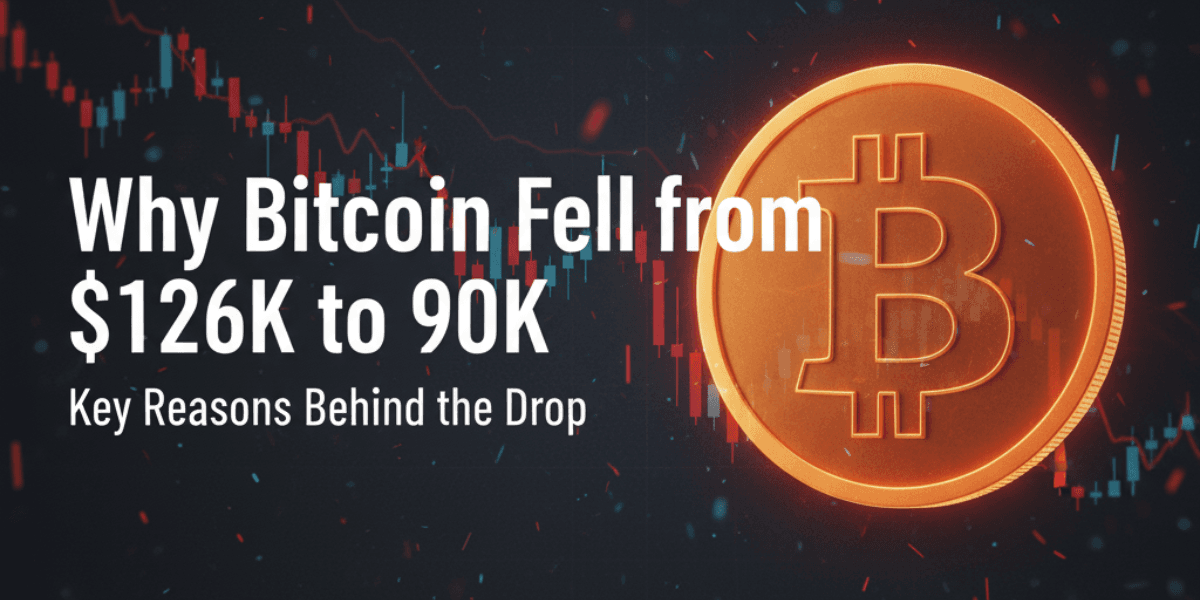Why Bitcoin Crashed from $126K to $90K: What Really Happened?

Bitcoin's incredible climb to $126,000 in October 2025 had everyone talking. Institutional money was pouring in, ETF inflows hit records, and confidence in digital assets seemed unstoppable. Fast forward to today, and we're looking at prices hovering around $90,000 to $95,000. Billions wiped out, and the entire crypto market feeling nervous.
So what happened? Why did things change so fast? Let's break down the real reasons behind this drop.
1. The Liquidity Squeeze Nobody Saw Coming
Here's something most people don't realize: even though crypto is decentralized, Bitcoin's price is still tied to how much money is flowing through the traditional financial system.
Recently, U.S. liquidity took a serious hit. The government shutdown in early November stopped federal spending cold. Reduced net federal outlays and delayed spending during the shutdown removed a source of liquidity. On top of that, bank reserves dropped to $2.8 trillion, which got so tight that the Federal Reserve had to step in with emergency lending operations.
Why does any of this matter for Bitcoin?
When there's plenty of money sloshing around the system, some of it finds its way into Bitcoin. When money gets tight, investors pull back from risky bets. Treasury bills suddenly look more attractive because they're safe and still pay decent yields.
Bottom line: less cash in the system means less cash flowing into crypto.
2. Rate Cut Confusion
Markets were pricing in Fed rate cuts, but guidance and data grew more uncertain, making the timing and size of cuts unclear.
The government shutdown made things worse by delaying important economic reports. Without good data, it's hard to predict what the Fed will do next. Mixed economic signals aren't helping either.
This uncertainty creates problems:
- Businesses and investors can't plan properly when borrowing costs are unclear
- Volatile assets like Bitcoin get hit harder when the future is fuzzy
- The dollar bounces around, which impacts crypto prices
When the path forward got murky, Bitcoin's rally stalled.
3. The Great ETF Reversal
Bitcoin ETFs were the rocket fuel behind the climb to $126K. Institutional money kept flowing in, month after month, creating steady demand.
Then everything flipped.
As Bitcoin hit its peak and started sliding, those ETF inflows didn't just slow down. They reversed completely. November 14th saw a massive $870 million flow OUT in a single day. That's not just institutions taking a breather. That's active selling.
Crypto markets are sensitive to these shifts. When the big players who drove prices up suddenly become sellers, it creates real downward pressure. Large ETF outflows not only remove buy pressure but can force liquidations and reduce market depth, amplifying price moves. The reversal from strong buying to heavy selling marked a turning point that's hard to ignore.
4. The Technical Death Spiral
Once Bitcoin broke below $100,000, things got ugly fast.
Traders using leverage got wiped out. Automated trading systems started dumping coins. Stop losses triggered more selling, which triggered even more selling. It's what traders call a cascade, and it's brutal to watch.
Crypto markets are smaller and less liquid than stock markets. That means when large sell orders hit, they move prices harder and faster. Once the technical charts broke down and momentum shifted negative, the drop accelerated on its own.
5. Markets Got Scared
Bitcoin wasn't falling in a vacuum. The broader investment world got nervous too.
Geopolitical tensions ramped up. The government shutdown created uncertainty about everything from economic data to policy decisions. Commodity markets got choppy. When things feel risky, investors run to safety.
Bitcoin has come a long way and gained serious institutional acceptance. But when markets get scared, it still gets treated like what it is: a high-risk, high-volatility asset. And those assets get sold first when fear takes over.
6. Profit Taking After a Wild Run
Let's be honest about what happened here. Bitcoin went on an absolute tear. When any asset rockets up that fast, people who got in early start thinking about locking in gains.
Once Bitcoin blew past $120K in October, holders who bought months or even years ago began selling. Some profit taking is normal and healthy. But when everyone tries to cash out at once, prices drop hard.
The current pullback of 25% to 28% from the peak might feel painful, but it's actually modest compared to Bitcoin's history. Previous bear markets saw drops of 50% to 80%. This could just be a normal correction within a longer bull run.
What Happens Next?
Ask ten analysts and you'll get ten different answers. But most agree on a couple of things:
First, the long-term picture still looks solid. Institutions are still involved, the network is strong, and adoption continues to grow.
Second, the short term is still risky. Until money starts flowing back into the system and ETFs flip back to buying, we could see more volatility.
Some analysts think Bitcoin could push toward $130K to $150K if conditions improve. Others warn that continued selling pressure could test support levels down around $74K to $82K, though that's more of a worst-case scenario than an immediate prediction.
The Bottom Line
Bitcoin didn't crash because of one single event. It crashed because several things happened at once.
The government shutdown sucked liquidity out of the system. ETFs went from record buying to record selling. Investor confidence wavered. Technical support levels broke. And after a massive run-up, people naturally wanted to take profits.
These kinds of corrections are part of how Bitcoin works. It's always been volatile. But what comes next depends on a few key things:
- Whether the government gets its act together and liquidity returns
- How clear the Federal Reserve can be about its plans
- If institutional buyers come back to Bitcoin ETFs
- Whether broader markets calm down or stay jittery
The October peak might end up being the top of this cycle. Or it might just be a pit stop on the way higher. Time will tell, but one thing's certain: this ride isn't over yet.




